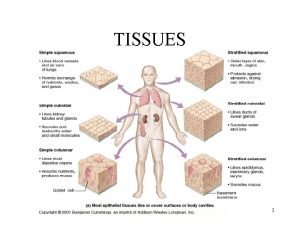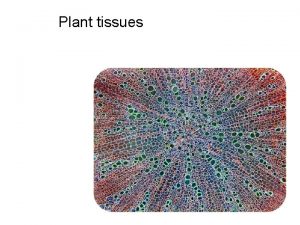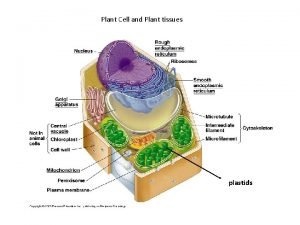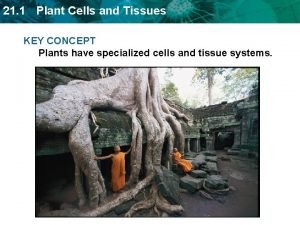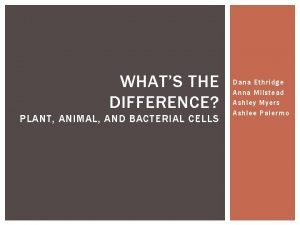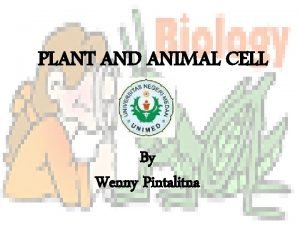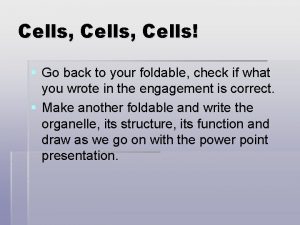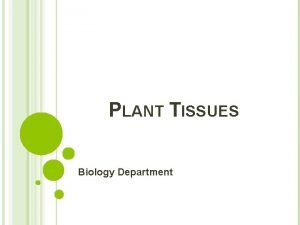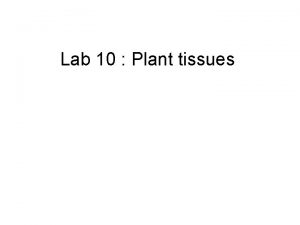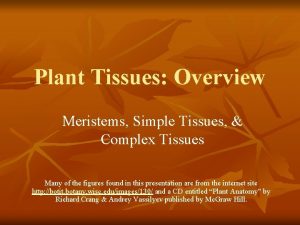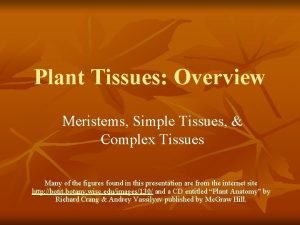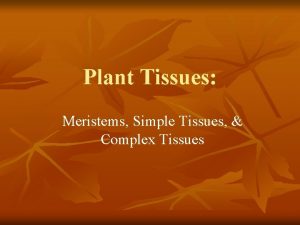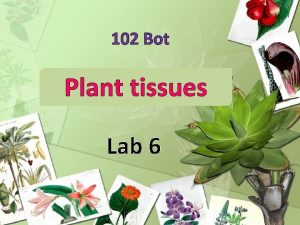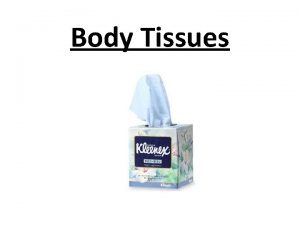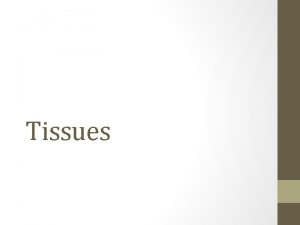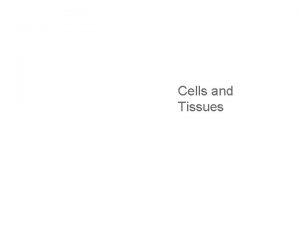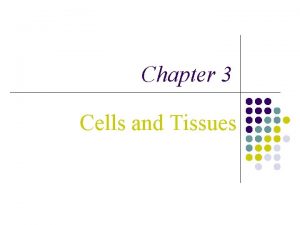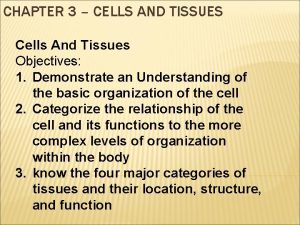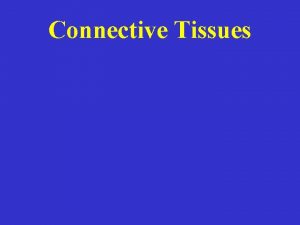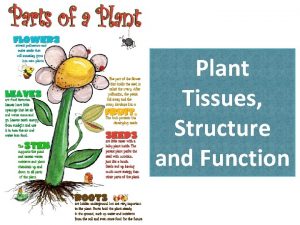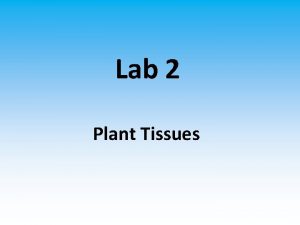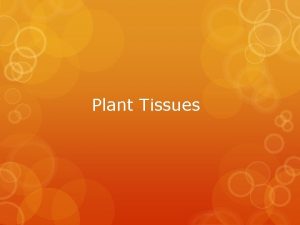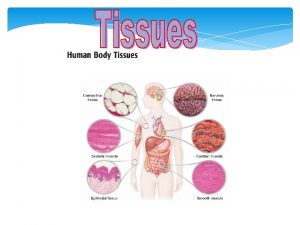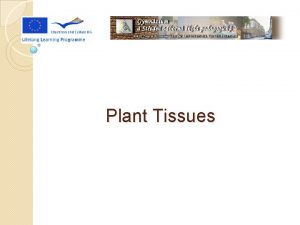Plant Cells and Tissues I General Information A




























- Slides: 28

Plant Cells and Tissues

I. General Information A. Three main plant cell types 1. Parenchyma 2. Collenchyma 3. Sclerenchyma

1. Parenchyma a. Can differentiate into all cell types a. Living cell, can still divide b. F(x)s = § § Plant growth Food production (photosynthesis) Food storage (e. g. potatoes) Wound healing & regeneration

2. Collenchyma a. Living cells b. Have thicker walls than parenchyma c. Can form long rope-like fibers (e. g. linen) d. Can stretch (occur in elongation zones) e. F(x) = strength, support, elongation

3. Sclerenchyma a. b. c. d. Usually dead while functioning Thick secondary wall, no stretch F(x) = strength, support 2 types: i. fibers ii. Sclereids (seed coats, nut shells & fruit)

I. General Information B. Three main types of plant tissue 1. Ground tissue 2. Dermal Tissue 3. Vascular Tissue

C. Ground tissue 1. Surrounded by dermal tissue 2. All tissue that is NOT dermal tissue or vascular tissue

C. Ground tissue 3. Contains all three types of cells (mostly parenchyma) 4. Make up most of non-woody roots, stems & leaves

C. Ground tissue 5. Many f(x)s § Photosynthesis § Food storage § Support

C. Ground tissue

D. Dermal Tissue 1. General a. Forms the “skin” (outside covering) of a plant b. Covers roots, stems & leaves c. F(x) depends on location

D. Dermal Tissue d. Examples: § Epidermis § Cuticle § Root Hairs § Stomata § Cork

D. Dermal Tissue 2. Epidermis a. Parenchyma b. Usually ONE cell thick c. Outer protective covering of young & mature woody plants

D. Dermal Tissue 3. Cuticle a. Waxy layer secreted by epidermis b. F(x) = prevent dehydration

D. Dermal Tissue 4. Root Hairs a. Modification of epidermis b. F(x) =Absorption of water from soil

D. Dermal Tissue 5. Stomata a. Location = stems & leaves b. F(x) = osmoregulation & regulation of gas exchange

D. Dermal Tissue c. Composition: § two guard cells § stoma (opening) Guard cells stoma

D. Dermal Tissue 6. Cork (bark) (Dead cells) a. F(x) = i. Replace epidermis in woody stems & roots ii. Protect plant cork

E. Vascular Tissue 1. F(x)s a. Transports water & nutrients b. Supports the plant

E. Vascular Tissue 2. Two kinds of vascular tissue a. Xylem b. Phloem

E. Vascular Tissue 3. Xylem a. F(x) = Conducts Water & Nutrients UP from roots (X elevator only goes up)

3. Xylem b. Two kinds of conducting cells i. Tracheids v long, thick-walled scelerenchyma v Thin separations between them

i. Tracheids § Water moves between them through PITS (thin porous areas of cell wall)

3. Xylem § ii. Vessel Elements (members) § Short, wide sclerenchyma § No end walls § No separations btwn. them (arranged end to end) § Not found in Gymnosperms

Tracheids vs Vessel Elements

4. Phloem a. F(x) = conducts the Products of Photosynthesis in every direction (P elevator moves in every direction)

4. Phloem b. Two kinds of conducting cells 1. Sieve Tube Member a. F(x) = Conduct sap b. Stacked to form long Sieve. Tubes

4. Phloem 2. Companion Cells a. Parenchyma b. F(x) = Control movement of sap through sieve tubes
 Body tissues chapter 3 cells and tissues
Body tissues chapter 3 cells and tissues Chapter 3 cells and tissues answer key
Chapter 3 cells and tissues answer key Body tissues chapter 3 cells and tissues
Body tissues chapter 3 cells and tissues Body tissues chapter 3 cells and tissues
Body tissues chapter 3 cells and tissues Cells form tissues. tissues form __________.
Cells form tissues. tissues form __________. Animal cell plant cell venn diagram
Animal cell plant cell venn diagram Which part of the cell contains genetic material
Which part of the cell contains genetic material Chapter 3 cells and tissues figure 3-1
Chapter 3 cells and tissues figure 3-1 Chapter 3 cells and tissues figure 3-1
Chapter 3 cells and tissues figure 3-1 Tissues are groups of similar cells working together to
Tissues are groups of similar cells working together to Tissues are groups of similar cells working together to
Tissues are groups of similar cells working together to Divisions of anatomy
Divisions of anatomy A group of cells similar in structure and function
A group of cells similar in structure and function Laboratory requirements for plant tissue culture ppt
Laboratory requirements for plant tissue culture ppt 3 tissues of a plant
3 tissues of a plant Ground tissue system
Ground tissue system Plastid
Plastid Cohesion bond
Cohesion bond Olfactory groove keros classification
Olfactory groove keros classification Red blood cells and white blood cells difference
Red blood cells and white blood cells difference Masses of cells form and steal nutrients from healthy cells
Masses of cells form and steal nutrients from healthy cells Plant and animal cells similarities
Plant and animal cells similarities Venn diagram of plant and animal cells
Venn diagram of plant and animal cells Small vacuoles
Small vacuoles What is the function of vacuole in the cell
What is the function of vacuole in the cell Plant and animal cells
Plant and animal cells How animal cells use nutrients
How animal cells use nutrients Plant and animal cells
Plant and animal cells Plant and animal cell foldable
Plant and animal cell foldable










